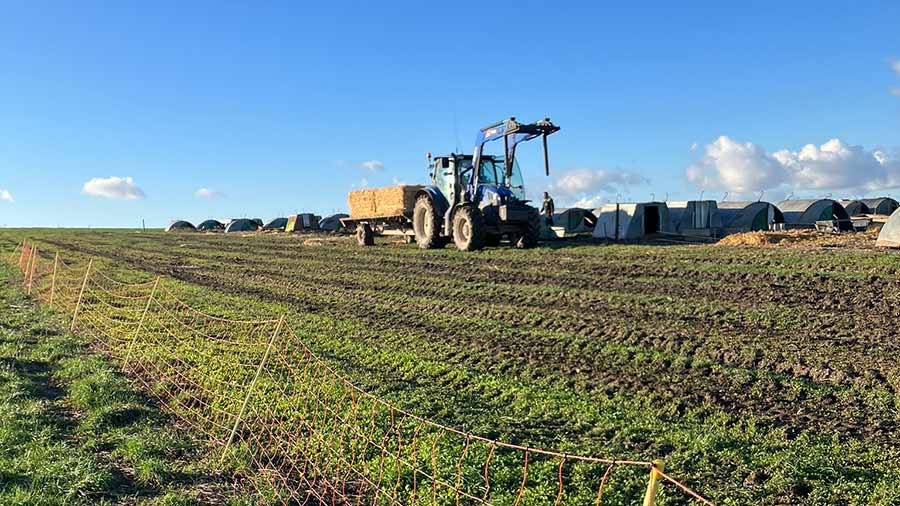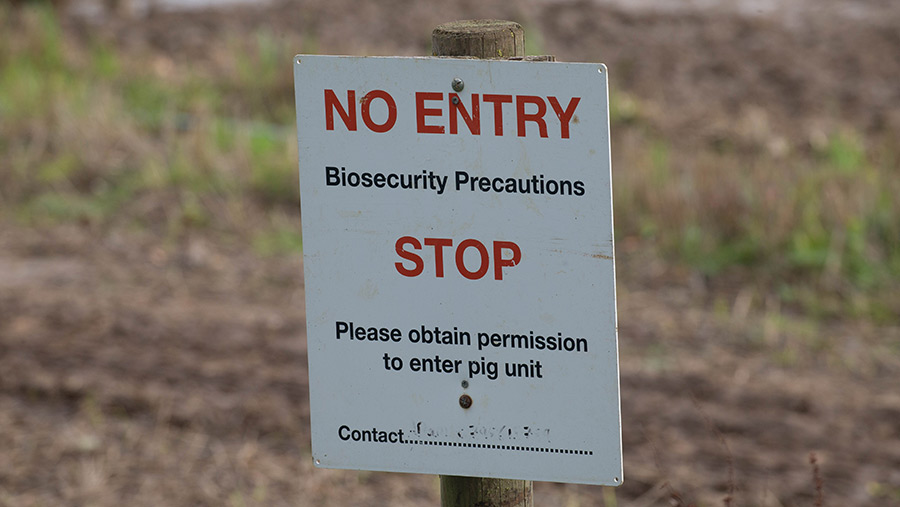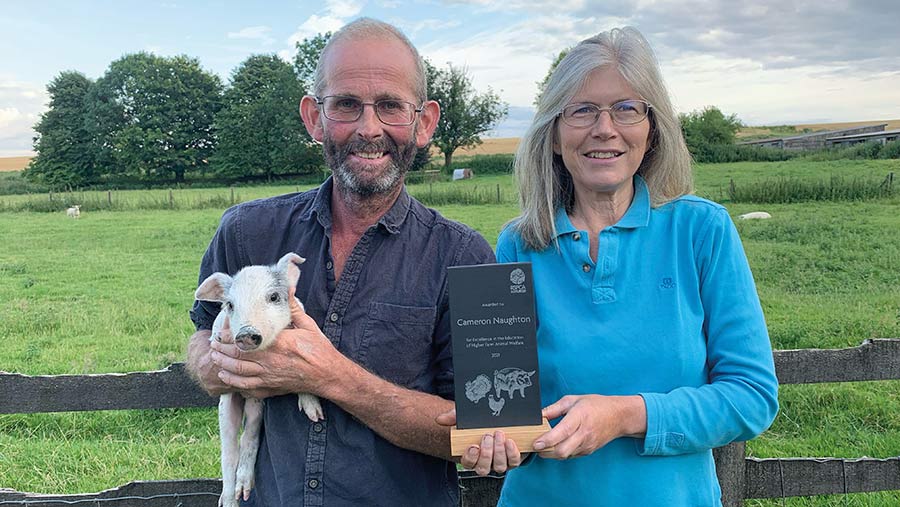5 ways to keep disease out of outdoor pig herds
 © Cameron Naughton
© Cameron Naughton African swine fever (ASF) is an ever-present risk to all pig herds, as are other endemic diseases that can affect health, welfare and productivity.
Outdoor herds are at a higher risk because of their exposure to wildlife, as well as the public via footpaths.
While it is impossible to remove all disease risks, it is important to put in place the best possible biosecurity measures and adapt them to the specific risks and practicalities of each farm.
See also: How to avoid transmission of the deadly ASF virus to pig herds
The good news is that the same key preventative steps help prevent many different diseases.
Pat Loten, AHDB knowledge exchange manager, and Cameron Naughton, Wiltshire-based outdoor pig producer, highlight the key issues and how to tackle them.
1. Control wildlife and vermin
- Birds pose a high risk of carrying pathogens such as E coli or salmonella.
- Any nearby landfill sites are a big risk, as birds may feed on waste food – including pork products, which can carry ASF – before feeding on the pig unit.
- TB remains a problem that is not always considered in pigs, particularly on units in the South West. Deer can spread it, too, but badgers are the greatest risk. Vets can help put together a protocol to keep wild animals out of the unit. One such measure might be erecting effective electric fencing around the unit.
- Keep on top of vermin, either by training members of staff or employing a professional pest controller, as pests can spread disease.
2. Ban the consumption of pork products on site
- No type of pork product should be brought on farm by anyone for lunch or snacks, not even into a staff room. Make sure all staff and visitors understand that the ASF virus can be carried and survive in pork for months.
- Signs should be put at the perimeter of outdoor units, particularly near footpaths, roads and lay-bys to inform walkers or drivers of this risk, too.
3. Isolate incoming pigs and vaccinate
- Other nearby pig units pose a risk of disease spreading from farm to farm through airborne transmission and the movement of people, vehicles and birds.
- If replacement gilts or any other pigs are brought into the herd, establish their health status and make sure they are isolated from the herd for a suitable quarantine period.
- Work with your vet to put in place a robust vaccination programme that is tailored to the herd’s specific disease challenges.
4. Implement strict biosecurity for staff and visitors
- Have barriers or gates at the unit entrance, even if these are temporary, with clear signage to ensure members of the public do not enter and visitors stop and follow biosecurity instructions.
- Make it clear where people need to stop and change boots and clothing, and disinfect.
- Have a visitor book to record people entering and leaving the unit, with a strict visitor policy that includes a minimum pig-clean period of at least 48 hours.
- Provide unit overalls and boots for staff and visitors.
- Create clear lines between clean and dirty areas. This can be trickier on outdoor units, but consider putting a Danish bench system in a staff room or hut – this is where a wooden bench or a plank is used as a divider. Staff and visitors then take off their own boots before swinging their legs over to the clean side where they put on the pig unit’s boots and clothing.
- Keep equipment clean and avoid sharing it between different parts of the unit.
- Regular, honest discussions with staff help identify possible improvements. A rota, to check specific tasks or items, can help provide a fresh set of eyes and make sure important routines do not slip, such as refreshing the disinfectant boot dips.

© Tim Scrivener
5. Vehicles
- Close entrance gates after traffic has passed through.
- Ensure deliveries or collections are made as far away from the pigs as possible.
- Send vehicles away if they are not clean and insist drivers use coveralls and boot covers.
- Provide cleaning and disinfection equipment for vehicles.
- Since the cost of fuel has risen, some producers have switched to a fallen stock collection service rather than incinerating on farm. Be aware of the potential disease risk from fallen stock lorries – this could be a false economy in the long run.
Biosecurity signs and posters can ordered from the AHDB website, free of charge.
Case study: Cameron and Muriel Naughton, Wiltshire

Cameron and Muriel Naughton
Farm facts
- Rent 344ha (850 acres) from the Crown Estate
- 400 sows, rearing piglets outdoors to weaning
- Closed herd since 2007
- Finishing all own progeny in straw-bedded sheds
- 283ha (700 acres) of arable crops
- More than 70% of pork sold directly to independent customers locally
- Opened their own farm shop October 2022
Wildlife is the biggest biosecurity challenge on Cameron and Muriel Naughton’s outdoor breeding unit. In 2020, the herd broke down with TB.
They tested clear in April 2021 and their vet advised installing suitable fencing to keep badgers away from the pigs.
They used sheep flexi-netting because it is easy to roll up and move and appears to be a sufficient wildlife deterrent.
“You need to make sure you keep the electric in the fence, otherwise piglets will nibble through it,” explains Mr Naughton.
They also have thousands of starlings that arrive on the farm in the winter.
The Naughtons use squeakers that emit the alarm calls of starlings or the noise of their predators, such as the peregrine, as well as whirlers, typically used for crop protection.
The birds get used to the deterrents, so they must move them around to maintain their effectiveness. They also have a licensed contractor who controls crows.
“We are fortunate that none of our neighbours keeps pigs, and we are not in a pig-dense region, so the risk of birds carrying disease onto the unit is lower,” says Mr Naughton.
African swine fever is a terrifying risk, with staff all aware of the importance of not bringing pork products onto the unit.
“We are fortunate that we do not have a public footpath running through the farm, but there is one close by. All staff know to politely ask anyone who strays off track to stay on the designated path.
“Gates are all locked when the team is not there and there are two signs saying ‘Private, no entry’, although they are sometimes ignored.”
They have installed a disinfectant spray gate at the main farm entrance, and all feed bins, liquid feed tanks and the loading bay are on the unit perimeter.
Visitors to the unit must be pig clean for 48 hours prior to entry and wear the farm’s boots. There is also a separate entrance for farm shop customers.
Improvements are continually sought during staff meetings.
